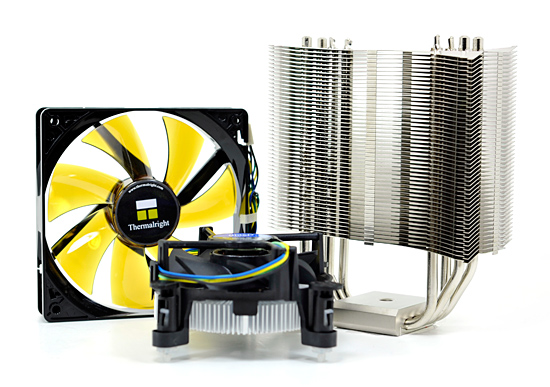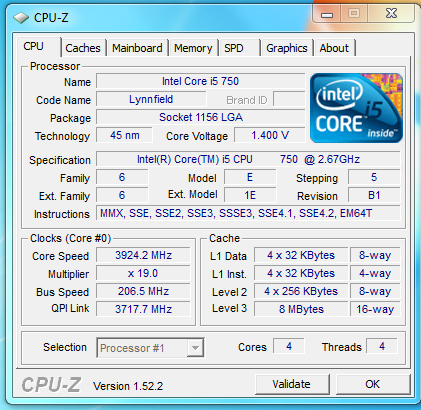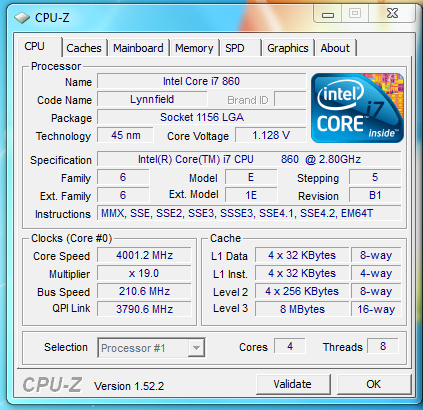Intel's Core i7 870 & i5 750, Lynnfield: Harder, Better, Faster Stronger
by Anand Lal Shimpi on September 8, 2009 12:00 AM EST- Posted in
- CPUs
Overclocking: Great When Overvolted, Otherwise...
Back when I asked Intel why anyone would opt for LGA-1366 over LGA-1156 one of the responses I got was: overclocking. The most overclockable CPUs will be LGA-1366 chips.
We tried overclocking three different CPUs: the Core i7 870, Core i7 860 and Core i5 750. We overclocked using two different coolers: the retail low profile HSF and a Thermalright MUX-120 (the heatsink Intel is sending around to reviewers for high performance testing). I'll get one thing out of the way: the retail heatsink pretty much sucks for overclocking:
| Intel Core i7 870 | Max Overclock (Turbo Disabled) |
| Intel Retail LGA-1156 Cooler | 3.52GHz (160MHz x 22.0) |
| Thermalright MUX-120 | 4.20GHz (200MHz x 21.0) |
The Thermalright enables higher overclocks by removing heat quickly enough allowing us to increase the voltage to the CPU. While roughly 1.35V is the limit for the retail cooler, The Thermalright MUX-120 let us go up to 1.40V. In both cases you need to have a well ventilated case.

Um, yeah.
Now for the actual overclocking results. We overclocked in two ways: 1) with turbo mode enabled and ensuring stability at all turbo frequencies (both single and multiple cores active), and 2) with turbo mode disabled simply going for highest clock speed.
The results are in the table below:
| CPU | Stock Clock Speed | Max Overclock (Turbo Enabled) | Max Overclock (Turbo Disabled) |
| Intel Core i7 870 | 2.93GHz | Default: 3.39GHz (154 x 22.0) 3C/4C Active: 3.70GHz | 4.20GHz (200 x 21.0) |
| Intel Core i7 860 | 2.80GHz | 3.23GHz (154 x 21.0) 3C/4C Active: 3.54GHz | 3.99GHz (210 x 19.0) |
| Intel Core i5 750 | 2.66GHz | 3.2GHz (160 x 20.0) 3C/4C Active: 3.96GHz | 3.92GHz (206.5 x 19) |
For best performance with all four cores active, disabling turbo mode is the way to go. Otherwise you have to reduce the BCLK in order to make sure your system is still stable when the one-active-core turbo mode kicks in. For example, with our Core i7 870 with turbo disabled we hit 4.2GHz using a 200MHz BCLK. If we used the same BCLK but left turbo enabled, when only one core was active we'd hit 5.4GHz - clearly not realistic with only air cooling.
The benefit of leaving turbo enabled is that you get a more balanced system that's not always using more power than it needs to.

The Core i5 750

Our Core i7 860 sample wasn't that great of an overclocker

Breaking 4.2GHz with our Core i7 870
At roughly 4GHz overclocks for all of these CPUs, it's reasonable to say that they are good overclockers. But how about with no additional voltage and the retail heatsink?
| CPU | Stock Clock Speed | Max Overclock, Turbo Disabled (No Additional Voltage) |
| Intel Core i7 870 | 2.93GHz | 3.37GHz (22 x 153MHz) |
The stock overclocks just plain suck on Lynnfield, you need added voltage to overclock the chip. With more voltage it works just like a Bloomfield or Phenom II, but at stock voltages Lynnfield just doesn't clock very high. And it has nothing to do with yields.










343 Comments
View All Comments
jasperjones - Tuesday, September 8, 2009 - link
Wonderful article as usual on AT. Read the articles on the website of your main competitor minutes before and didn't learn nearly as much about the LGA 1156 platform as I did here. Well done!I have one somewhat cheap comment. I always feel there's only one thing I do for which I really "need" my Core i7. And that's test-driving and debugging my well-threaded code (which makes use of OpenMP, MPI, threaded Intel MKL, etc.) before scp-ing it over to a cluster. Obviously, when testing code, I run using 8 threads. Still think that the Core i7 is probably more competitive in that area (performance/$ wise) than in the ones which this review focuses on (simply because I assume such code puts enough stress on the processors such that turbo-boosting is out of the question). On the other hand, I don't really care if gzip takes 2.5 or 3 seconds to compress a file (or if flac takes 8 or 9 seconds to encode my wav).
As I said, it's a cheap point. Just saying that I feel I primarily need "oomph" when running well-threaded stuff. Again, great article!
AeroWB - Tuesday, September 8, 2009 - link
Thanks for the interesting read, I do agree with some other people that some things are missing (clock for clock comparison) and some things are weird (core i7 with 1066DDR3). Some people are saying that everyone is overclocking their core i7, and while most readers of this article will probably be geeks that overclock I also read these articles as a systembuilder and I know that at least 95% of my customers don't overclock, so I really dig non-overclocked comparisons and results.There is also one thing I do not agree on, lets have another look at the page "The Best Gaming CPU?" and look to the DoWII results. What I see there is totally different from your conlusion though you do mention it in the text, the Bloomfield has lower minimum framerate then Lynnfield, but still your conclusion is Bloomfield is better then Lnynfield and Lynnfield is better then the Core2E8600. Ehm ???
Lets be clear the core i7 920 really sucks here as of its really low minimum fps you will have stutters. Great gaming is all about having a butter smooth FPS which dependent on the game type needs to be between 30 and 60 FPS. Basically the best game experience here will probably be with the E8600 as it has the highest minimum at 33 FPS which is great for RTS gaming. In order to say which CPU is best you should have an extra statistic like how much and how long the framerate dropped below 30FPS or something but as we do not have this data the minimum framerate is our next best thing. As weve seen before the Core i7 is good when using SLI/Crossfire but on par with the core2 when using a single GPU. Intel also told us themselfs that Core i7 was not made for gaming but for taking a bigger part in the server market. When increasing resolution/quality of gaming when using one GPU the Phenom 2 was often as fast and sometimes even faster then the Core i7. Unfortunately most CPU comparison with gaming are done at low to medium resolutions and quality so this effect couldn't be seen in most tests, but there were very few where this could be seen. So gaming with Core i7 920 only made sense when using SLI/Crossfire (as it scaled much better with these then Phenom2) or when paying the extra money (over Phenom2) because you used the system mostly for other task like video editing or so.
Now we can see this gaming problem of the Core i7 has been (at least partly) solved with Lynnfield, but still the Phenom2 965 has a higher minimum then the Core i5 750 so I would still prefer that one.
The other gaming test are not really relevant as all cpu's score a minimum of 60 FPS (ok one exception on 59) and so you won't notice any difference between all of the tested CPU's with those settings.
Still it is probable that the better gaming CPU in these test will also be better with higher settings, but as I have seen with the weird Core i7 / Phenom2 results I want to see tests with higher settings or test with more demanding games. And we want minimum and average results to determine which is best.
Sorry for the long post
iwodo - Tuesday, September 8, 2009 - link
I am waiting for SandyBridge or even Ivy Bridge for FMA.For now, a C2Q two years ago with money spent on graphics card will do fine.
The whole LGA socket and naming is a complete mess.
Dont get me wrong, it is a good Processors, but not the jump from Pentium 4 to C2D.
Money spend on SSD and Graphics is much better valued.
JonnyDough - Tuesday, September 8, 2009 - link
My dual core Opty 185 is still doing fine...Fallout 3 is still playable with my 8800GTS 640. The system has a slight OC and is chugging along at a minimum of 45FPS in the game on decent settings. Granted, it can't play every game - but I can only play one at a time anyway, and my life does not revolve around gaming. Hello...BEER PONG!Griswold - Tuesday, September 8, 2009 - link
I agree. I'll get excited when the 32nm dual cores with HT arrive. That would be a worthwhile "upgrade" (but a downgrade in number of cores, simply because I dont need 4 physical cores that much anymore) from my q6600 on a p35.Still, its a good product, just not worth an upgrade for everyone.
strikeback03 - Tuesday, September 8, 2009 - link
I was hoping there would be 32nm quads in this cycle, but it appears not. I'd definitely like something faster than my E6600/P965, but don't think it is worthwhile in time or money to just go to a C2Q.R3MF - Tuesday, September 8, 2009 - link
I spent much of the past year harping on AMD selling Nehalem-sized Phenom IIs for less than Intel sold Nehalems. With Lynnfield, Intel actually made Nehalem even >>>bigger<<< all while driving prices down.i think you mean smaller.
strikeback03 - Tuesday, September 8, 2009 - link
Nope, he meant bigger. Same process + more transistors = larger die, as is illustrated in the table.JonnyDough - Tuesday, September 8, 2009 - link
I think AMD realized years ago that they had awoken a sleeping giant, and it was a smart move to start thinking about competing graphically when they did. They saw how IBM had to change when Intel reared its ugly head. If you put all your eggs in one basket, you'll surely drop your next meal at some point. Diversifying into new markets was a smart move. Anyone who said that AMD didn't have good leadership didn't know what they were saying. Sure, money got really tight - but that's what has to happen to someone in a very competitive market at some point. Just take a look at GM. Giants crumble, little guys take over, and giants can muster a comeback...blyndy - Tuesday, September 8, 2009 - link
"I think AMD realised years ago that they had awoken a sleeping giant, and it was a smart move to start thinking about competing graphically when they did."That's an interesting thought.
I think there were to mains reasons why AMD acquired ATI.
1) in response to the news of Larrabee -- pre-emptive defensive move.
2)To diversify in preparation for Intels technological onslaught to finally kill its only CPU competitor.
So it may have been a smart move. On the other hand, knowing how patent riddled the CPU business is, maybe they could have ramped up R&D, but AMD is puny next to Intel.